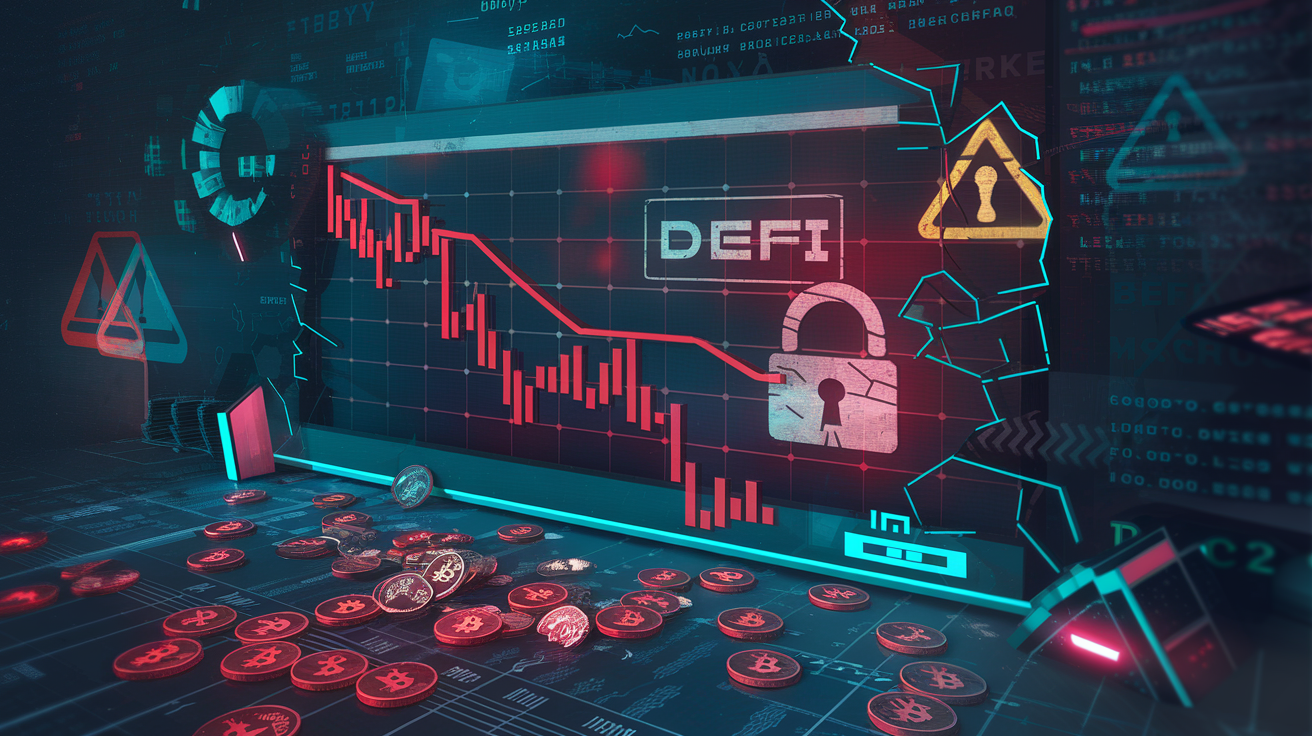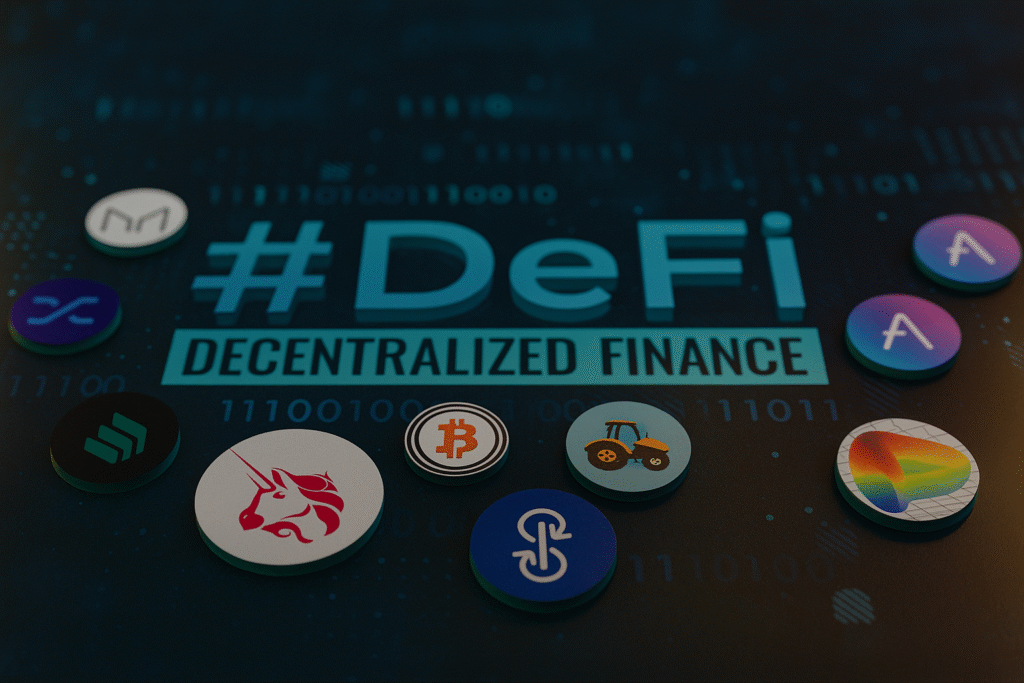You just deposited your life savings into a DeFi protocol promising 20% APY. Then you wake up to find the platform drained by hackers overnight. Sound terrifying? For thousands of crypto investors, this DeFi risk assessment nightmare became reality in 2023.
Decentralized Finance (DeFi) has exploded from a $1 billion experiment to a $50+ billion ecosystem in just a few years. But beneath those mouth-watering yields lurks a labyrinth of risks most flashy YouTube influencers conveniently ignore.
In this no-nonsense guide to DeFi investing, I’ll show you what the “get-rich-quick” crowd won’t: the actual risk-reward calculation smart money is making in 2025.
But first, let me ask you something that might change how you view this entire space: what if the biggest risk in DeFi isn’t what you think it is? Here’s a deeper dive into DeFi risks that might surprise you.
Understanding DeFi: Beyond the Buzzword

What exactly is decentralized finance and why it matters
DeFi isn’t just another tech buzzword—it’s a financial revolution happening right under our noses.
Decentralized finance is built on the idea of cutting out the middlemen—eliminating banks, brokers, and clearinghouses that take a slice of your money or impose restrictions on how you use it. This freedom is powerful, but it comes with responsibility. Without solid crypto risk management, that same openness can expose you to serious vulnerabilities.
Instead, DeFi uses blockchain technology and smart contracts to create financial services that run automatically. Want to take out a loan at 3 AM? Go ahead. Need to swap currencies instantly without filling out paperwork? You can do that too.
The big deal here is that DeFi puts you in control of your own money. You hold the keys (literally, cryptographic keys) to your own financial future. This matters because traditional financial systems have left billions of people without access to basic services, charged excessive fees, and crashed spectacularly (remember 2008?).
The evolution from traditional finance to DeFi
Traditional finance has stood for centuries, yet its core mechanics remain stubbornly outdated. Opening an account often requires permission and paperwork. Transactions can take days to process, and the fees? You pay what you’re told—no questions asked.
The journey toward DeFi started with Bitcoin in 2009. For the first time, people could transfer value directly to each other without a bank. But Bitcoin was just digital cash—the real breakthrough came with Ethereum in 2015, which added programmability to blockchains.
The DeFi boom really took off in 2020, with the “DeFi Summer” seeing billions of dollars flowing into protocols like Uniswap, Aave, and Compound. What started as a niche experiment became a legitimate alternative financial system practically overnight.
Today, we’re seeing traditional finance slowly adopting DeFi concepts while DeFi platforms are maturing with better security and user experiences.
Key technologies powering the DeFi ecosystem
Smart contracts are the engine of DeFi—self-executing code that automatically enforces agreements between parties. No lawyers needed.
These contracts run on blockchains—mostly Ethereum, but increasingly on competitors like Solana, Avalanche, and Binance Smart Chain. A thorough DeFi risk assessment starts with understanding how the blockchain provides the trust and transparency that makes the whole system work.
Then there are the building blocks of the DeFi ecosystem:
- Decentralized exchanges (DEXs) like Uniswap that let you trade tokens without intermediaries
- Lending protocols like Aave where you can borrow or lend cryptocurrency
- Stablecoins like DAI that maintain steady value
- Yield farming platforms that help you earn interest on your crypto
All these pieces work together like financial Lego blocks, allowing developers to create increasingly sophisticated financial products.
How DeFi differs from traditional cryptocurrency investments
Crypto investing used to be simple: buy Bitcoin, hold it, and hope the price goes up. DeFi changes the game completely—introducing new layers of opportunity and Web3 investment risk that demand a deeper level of strategy and understanding.
With DeFi, your crypto doesn’t just sit there—it works for you. You can lend it out for interest, provide liquidity to exchanges and earn fees, or stake it to help secure networks.
The differences go deeper:
| Traditional Crypto | DeFi |
|---|---|
| Mostly speculative | Provides actual financial utility |
| Limited to buying/selling | Enables lending, borrowing, insurance, etc. |
| Centralized exchanges control your funds | You maintain control of your assets |
| Requires trust in exchanges | Trust is replaced by code and math |
DeFi also comes with unique risks—smart contract bugs, protocol hacks, and “impermanent loss” are terms every DeFi user learns quickly (sometimes the hard way).
But the fundamental promise remains: financial services that are open to anyone, run 24/7, and can’t be shut down or censored by any single entity. Still, a solid DeFi risk assessment is crucial to navigate this freedom responsibly.
The Undeniable Benefits of DeFi

Financial inclusion: Banking the unbanked globally
DeFi tears down the walls that traditional banks have built around financial services. Think about this: nearly 1.7 billion adults worldwide don’t have access to basic banking. But with just a smartphone and internet connection, DeFi protocols give anyone—regardless of their location, wealth, or status—access to lending, borrowing, and investing.
A farmer in rural Kenya can now earn interest on their savings without needing to travel hours to the nearest bank branch. A Venezuelan citizen can escape hyperinflation by holding stablecoins. This isn’t theoretical—it’s happening right now.
Removing intermediaries: Lower costs and faster transactions
Banks and financial institutions take a massive cut from nearly every transaction. That $30 wire transfer fee? That 3% credit card processing charge? In DeFi, they’re practically gone.
Smart contracts automate what traditionally required human intermediaries, slashing costs dramatically. Cross-border payments that once took days and cost a fortune now happen in minutes for pennies. A recent analysis showed DeFi users save an average of 82% on transaction fees compared to traditional finance.
Unprecedented transparency through blockchain technology
In traditional finance, you’re left in the dark. Remember 2008? Nobody knew what toxic assets were hidden in those balance sheets until everything collapsed.
With DeFi, every transaction is recorded on a public blockchain. Want to see exactly how a protocol calculates interest rates? Check the code—it’s open source. Want to verify a platform’s reserves? The blockchain shows you in real-time. No more “trust us” banking—DeFi gives you “verify it yourself” finance.
Innovative yield opportunities not available in traditional finance
Your bank offers what, 0.01% interest on savings? Meanwhile, DeFi users access yields that make traditional bankers sweat.
Liquidity providing, yield farming, and staking offer returns that simply don’t exist in traditional finance. Even conservative DeFi strategies frequently deliver 5–10% APY, while more aggressive approaches can yield significantly more. These aren’t gimmicks—they’re legitimate economic activities compensating users for providing valuable services to these networks. But without a proper DeFi risk assessment, those high rewards can come with equally high risks.
24/7 market access without geographic restrictions
Traditional markets sleep. They close for weekends, holidays, and after-hours. DeFi never sleeps.
Trading, borrowing, lending—it all happens 24/7/365. A brilliant investment idea at 3 AM on Sunday? Execute it immediately. Need emergency funds while traveling internationally? Access them instantly without calling your bank or dealing with foreign exchange offices.
DeFi truly delivers global finance that works on your schedule, not the other way around.
Real Risks in the DeFi Landscape

Smart Contract Vulnerabilities and Past Exploits
The DeFi world has had its fair share of nightmare scenarios. In 2020 alone, hackers stole over $100 million through various DeFi exploits. Why? Smart contracts might be revolutionary, but they’re only as good as their code—making a rigorous DeFi security review essential before trusting any platform with your funds.
Remember the DAO hack back in 2016? A single coding flaw led to $60 million being drained. More recently, in 2023, Euler Finance lost $197 million in a flash loan attack. These weren’t small, obscure projects—they were major protocols with substantial audits.
The problem is simple: code is written by humans, and humans make mistakes. Even one tiny vulnerability can lead to catastrophic losses. And unlike traditional finance where you might get your money back after a fraud claim, in DeFi, there’s often no recourse—making a thorough DeFi risk assessment more critical than ever.
Many projects now use multiple auditing firms and offer bug bounties, but the risks remain. Some developers even deliberately insert backdoors—these “rug pulls” have become all too common.
Regulatory Uncertainty and Compliance Challenges
DeFi exists in a regulatory gray zone that keeps evolving. One day your assets are perfectly legal, the next day they might not be.
The regulatory landscape is a patchwork quilt:
| Region | Approach to DeFi |
|---|---|
| USA | Fragmented oversight between SEC, CFTC, FinCEN |
| EU | MiCA regulations bringing some clarity |
| Singapore | Relatively progressive framework |
| China | Complete ban on crypto transactions |
For users, this creates serious headaches. You might unknowingly violate laws in your jurisdiction. For project developers, compliance costs are skyrocketing as they try to navigate this maze.
Tax reporting is another nightmare. Most tax authorities haven’t created clear guidelines for DeFi activities like yield farming or liquidity providing. Good luck explaining impermanent loss to your accountant!
Impermanent Loss Explained in Simple Terms
Here’s the thing about impermanent loss—it’s anything but impermanent when it happens to you.
Imagine you deposit equal values of ETH and USDC into a liquidity pool. If ETH’s price doubles while it sits in that pool, you’d actually have less total value than if you’d just held those assets separately. Why? Because the pool automatically rebalances to maintain its 50/50 ratio.
This isn’t a bug—it’s by design. Automated market makers need this mechanism to function. But for liquidity providers, it can eat into (or completely erase) any fees earned.
The more volatile the assets, the worse the impermanent loss can be. Stablecoin pairs help minimize this risk, while speculative token pairs can suffer devastating impermanent loss during market swings. A proper DeFi risk assessment should always account for this hidden danger.
Market Volatility and Liquidity Concerns
Crypto makes traditional market volatility look like a kiddie pool. Bitcoin dropping 20% in a day isn’t unusual, and smaller DeFi tokens can swing 50% or more.
This extreme volatility creates cascading problems in DeFi:
- Liquidations: When prices plummet, collateralized loans get liquidated, often at unfavorable rates
- Liquidity crunches: In panic moments, liquidity can vanish instantly
- Oracle failures: Price feeds can lag or break, triggering incorrect protocol actions
The liquidity risk is particularly severe in smaller protocols. You might find yourself unable to exit a position during market stress—your assets technically valuable but practically unsellable.
Flash crashes are another danger. In 2021, ETH briefly crashed to $700 from $1,900 on Kraken. Anyone using margin at that moment faced instant liquidation, even though the “real” market price hadn’t crashed nearly as much.
Security Best Practices for DeFi Investors

A. Due diligence: How to evaluate DeFi protocols before investing
The DeFi space is filled with projects promising astronomical yields and revolutionary financial products. But not all that glitters is gold. Smart investors know that proper due diligence separates the winners from the scams.
First, check the protocol’s age and track record. Platforms that have survived multiple market cycles typically have stronger foundations. Look for protocols that have been around for at least a year and weathered market downturns—this is a key step in assessing DeFi platforms before you invest.
The audit situation is non-negotiable. Never put money into a protocol without multiple security audits from reputable firms like CertiK, Quantstamp, or Trail of Bits. Read those audit reports yourself – don’t just check if they exist.
Team transparency matters enormously. Anonymous teams aren’t necessarily bad, but you should demand more proof of legitimacy from them. Research team members’ backgrounds, previous projects, and their social media presence.
Check the TVL (Total Value Locked) trend over time. A steadily growing or stable TVL suggests user confidence, while dramatic drops might indicate problems. Compare the protocol’s TVL with competitors to gauge its market position.
Don’t ignore the community. Active Discord and Telegram channels with substantive discussions (not just moon talk) signal a healthy ecosystem. Red flags include censorship of legitimate questions and moderators who dodge technical concerns. A well-rounded DeFi risk assessment should always include evaluating the strength and transparency of the project’s community.
The tokenomics can make or break your investment. Ask these questions:
- What’s the token distribution?
- Is there a massive allocation to insiders?
- Are there vesting schedules?
- Does the token have actual utility?
B. Wallet security essentials
Your wallet is your financial lifeline in the DeFi world. Treat it accordingly.
Hardware wallets like Ledger or Trezor provide the gold standard for security. Yes, they cost money, but can you really put a price on protecting your crypto fortune? Software wallets are convenient but inherently less secure.
Never, ever store your seed phrase digitally. Not in your email, not in your cloud storage, not in a password manager. Write it down on paper or stamp it on metal plates and store them in secure, separate locations. If someone gets your seed phrase, your funds are gone forever.
Create a system of multiple wallets for different purposes:
- A cold storage wallet for long-term holdings
- A DeFi interaction wallet with limited funds
- A small “hot wallet” for quick transactions
Enable all available security features. Multi-signature requirements, timelock functions, and spending limits can save your portfolio if one access point gets compromised.
Be cautious about connection requests. When connecting your wallet to a DeFi platform, double-check the URL, use bookmarks, and disconnect your wallet after completing transactions. Those “wallet connect” requests on random Discord servers? Just say no.
C. Risk diversification strategies specific to DeFi
DeFi risk works differently than traditional finance. Your diversification strategy needs to reflect this reality.
Protocol risk is the biggest concern. No matter how fantastic a particular yield farm looks, never put more than 20% of your portfolio into a single protocol. Even the bluest of blue-chip DeFi projects have suffered exploits—making a basic smart contract risk check non-negotiable before committing capital.
Layer diversification matters. Spreading investments across Ethereum, Solana, Avalanche, and other ecosystems ensures you’re not vulnerable to network-specific issues. When Solana goes down (and it will), your Avalanche positions keep working.
Spread across DeFi verticals:
- Lending platforms
- Automated market makers
- Derivatives protocols
- Yield aggregators
- Insurance products
Speaking of insurance, it’s not exciting—but it’s smart. Platforms like Nexus Mutual and InsurAce let you hedge against smart contract failures. The premiums eat into your yield, but they’re worth ideft for larger positions. Factoring this into your DeFi risk assessment can mean the difference between a setback and a financial disaster.
Consider correlation in your strategy. During market panics, seemingly unrelated DeFi tokens often crash together. True diversification means including some counter-cyclical assets that might perform differently during crises.
Navigating the Regulatory Environment

Current regulatory approaches to DeFi worldwide
The regulatory landscape for DeFi looks like a patchwork quilt right now. Different countries are taking wildly different approaches, creating a confusing environment for users and developers alike.
The US has taken a somewhat aggressive stance, with the SEC claiming jurisdiction over many DeFi products by arguing they’re securities. Meanwhile, Singapore has created a sandbox approach that allows innovation while keeping some guardrails in place. Switzerland’s “Crypto Valley” offers one of the most welcoming environments, with clear guidelines that don’t stifle growth.
On the flip side, China has banned virtually all crypto activities, DeFi included. The EU is somewhere in the middle with MiCA regulations that acknowledge DeFi’s existence but don’t fully address its unique characteristics.
How regulation might evolve in the coming years
The regulatory future isn’t written in stone, but certain trends are becoming clear. By 2026, we’ll likely see more targeted DeFi regulations rather than trying to force-fit existing frameworks.
Smart contract auditing standards are probably coming—think of them as the DeFi equivalent of bank stress tests. Regulators are also eyeing KYC/AML requirements for DeFi platforms, though the technical implementation remains tricky at best. As part of any thorough DeFi risk assessment, staying ahead of these regulatory shifts is key.
The most forward-thinking jurisdictions are exploring “regulatory nodes” – participation in DeFi protocols by government entities that can monitor without shutting systems down. This represents a shift from regulation-by-enforcement to regulation-by-participation.
Balancing innovation with consumer protection
This is the tightrope everyone’s trying to walk. Go too heavy on regulation, and you kill the innovation that makes DeFi revolutionary. Too light, and users get burned in spectacular fashion (looking at you, Terra Luna).
The most promising approach seems to be risk-based regulation. High-risk activities like leverage trading face stricter oversight, while basic swaps and staking get lighter treatment—a recognition of the varying degrees of blockchain investment risks across DeFi use cases.
Consumer education is also becoming a regulatory focus. Some jurisdictions are requiring DeFi protocols to provide clear risk assessments and educational materials before users can access certain features.
Self-regulation through industry associations is gaining traction too. Organizations like the DeFi Alliance are developing standards and best practices that might preempt heavy-handed government intervention.
Tax implications for DeFi participants
The tax situation for DeFi users is, frankly, a mess. Most tax authorities haven’t caught up with the technology, leaving users in a gray area.
Every transaction in DeFi – swaps, adding liquidity, staking, unstaking – potentially triggers a taxable event. And good luck tracking all those transactions across multiple chains and protocols.
Some countries are taking a pragmatic approach. Portugal, for instance, doesn’t tax crypto gains for individual investors. Germany exempts crypto held over a year from capital gains tax.
The rise of DeFi tax software is helping users navigate this complexity. Tools like Koinly and TaxBit can now track DeFi positions across protocols, though with varying degrees of accuracy.
Watch for more clarity by 2026 as tax authorities develop specific DeFi guidance. Until then, keeping meticulous records of your DeFi activities is your best defense against future tax headaches.
The Future Risk Profile of DeFi

How institutional adoption is changing risk dynamics
The DeFi landscape is transforming right before our eyes. Two years ago, institutions watched from the sidelines. Now? They’re diving in headfirst.
This shift is reshaping risk in fascinating ways. For starters, these big players bring serious capital—we’re talking billions, not millions. More liquidity means less price slippage and more stable protocols overall. But this evolution also demands a more nuanced DeFi risk assessment, as institutional involvement introduces new dynamics and dependencies.
But here’s the kicker: institutional money comes with institutional demands. Compliance, auditing standards, and regulatory frameworks are being built into protocols that once prided themselves on being the wild west of finance.
Goldman Sachs, BlackRock, and JPMorgan aren’t just dipping their toes in anymore. They’re building entire DeFi divisions and demanding enterprise-grade risk management.
The risk profile is changing from “move fast and break things” to “trust but verify.” Smart contract audits have gone from optional to mandatory. Protocol insurance is becoming standard practice rather than a nice-to-have.
Insurance solutions emerging in the DeFi space
DeFi insurance has exploded since 2023. Remember when Nexus Mutual was basically the only game in town? Those days are long gone.
Now we’ve got specialized coverage for everything:
- Smart contract failure insurance
- Oracle manipulation protection
- Governance attack coverage
- Stablecoin de-pegging safety nets
Insurace, Unslashed Finance, and Bridge Mutual have created entire ecosystems around risk protection. The model has evolved too—parametric insurance now automatically pays out when certain conditions are met, no claims process required.
What’s game-changing is how these insurance protocols are using their own tokens to align incentives. Staking insurance tokens helps determine premiums and payouts, creating a community-driven risk assessment framework that traditional insurance companies can only dream about. It’s a novel form of crypto risk evaluation built into the fabric of decentralized systems.
Technological improvements addressing current vulnerabilities
The tech behind DeFi is leveling up fast. Remember those horrific bridge hacks of 2022-2023? Those vulnerabilities are being squashed through zero-knowledge proofs and formal verification methods that mathematically prove code security.
Layer 2 solutions have matured dramatically, cutting gas fees while boosting security. Optimistic rollups and ZK-rollups aren’t just theoretical anymore—they’re processing millions of transactions daily with near-perfect security records. Including these advancements in your DeFi risk assessment is essential to understanding the evolving infrastructure landscape.
Smart contract languages themselves have evolved. Move and Rust are challenging Solidity’s dominance by offering memory-safe alternatives with fewer attack vectors.
Cross-chain communication protocols like LayerZero and Axelar have standardized secure messaging between blockchains, dramatically reducing the attack surface that plagued early bridge designs.
Even oracle solutions have stepped up their game. Chainlink’s Off-Chain Reporting and API3’s first-party oracles have virtually eliminated the data manipulation attacks that were once a major vulnerability.
Potential for self-regulation within the ecosystem
The DeFi community isn’t waiting for governments to tell them what to do. They’re building their own guardrails.
DeFi alliances like the DeFi Education Fund and the Blockchain Association are developing best practices that are becoming industry standards. Projects that don’t follow these guidelines increasingly struggle to gain traction.
Code audits aren’t just recommended—they’re expected. Multiple independent audits from firms like Trail of Bits, OpenZeppelin, and Certik have become table stakes for any serious project.
On-chain reputation systems are the next frontier. Protocols like Debank and DefiLlama are scoring projects based on transparency, code quality, and governance structures. These scores matter—users are paying attention.
Governance has matured too. The days of a few whales controlling every vote are fading as quadratic voting and delegation systems create more balanced power structures.
Balance of risk and reward in the maturing DeFi landscape
DeFi’s risk-reward profile has fundamentally evolved. Those sky-high 1000% APYs? Largely a thing of the past. But along with them, many of the rug pulls and exploits that once made DeFi feel like the financial wild west have also begun to fade.
Today’s reality is more nuanced:
| Risk Level | Typical APY (2025) | Risk Mitigation Features | User Profile |
|---|---|---|---|
| Low | 3-8% | Multiple audits, insurance, established history | Institutions, conservative retail |
| Medium | 8-15% | Audited, some insurance, good reputation | Experienced DeFi users |
| High | 15-30%+ | Newer protocols, innovative features | Risk-tolerant speculators |
The market is clearly segmenting. Aave, Compound, and MakerDAO have positioned themselves as the “blue chips” with institutional-grade security and moderate yields. Meanwhile, newer protocols still offer higher rewards for those willing to take the risk.
What’s different now is transparency. Risk isn’t eliminated—it’s quantified, packaged, and priced appropriately. Users can make informed choices rather than stumbling blindly into protocol failures.
Final Thoughts

Decentralized finance holds tremendous promise, offering financial accessibility, innovation, and autonomy that traditional systems cannot match. Yet, as we’ve explored, DeFi’s risks—from smart contract vulnerabilities to regulatory uncertainty—are significant and cannot be dismissed. The key to participating safely lies in implementing robust security practices, conducting thorough research, and maintaining a diversified approach to your investments through diligent DeFi due diligence.
The future of DeFi will likely be shaped by a balance between innovation and security, with evolving regulations helping to establish guardrails without stifling progress. Whether DeFi is ‘too risky’ ultimately depends on your risk tolerance, technical knowledge, and investment objectives. A thoughtful DeFi risk assessment—paired with both enthusiasm and caution—can help investors harness DeFi’s transformative potential while minimizing exposure to its inherent risks. In this rapidly evolving landscape, continuous learning and adaptation remain your most powerful tools. Looking for more actionable advice? Head to the Investillect blog.

